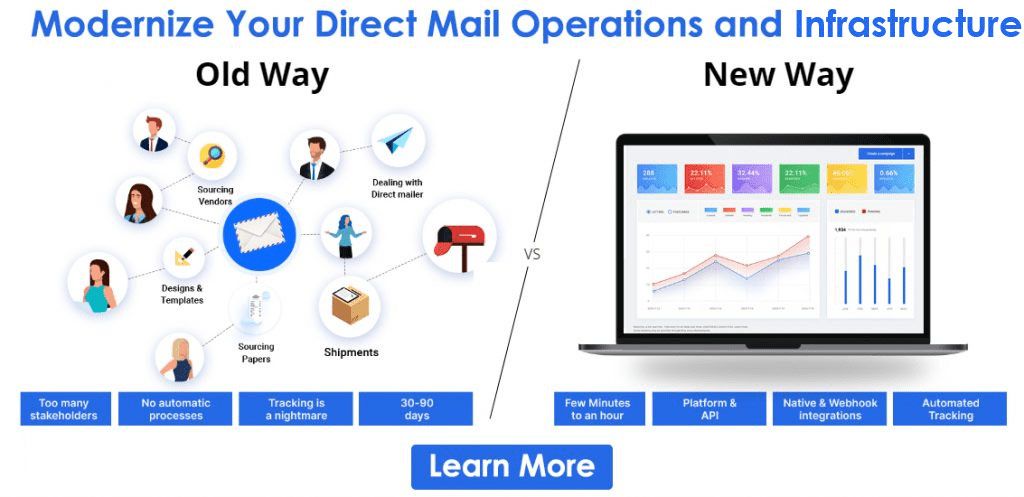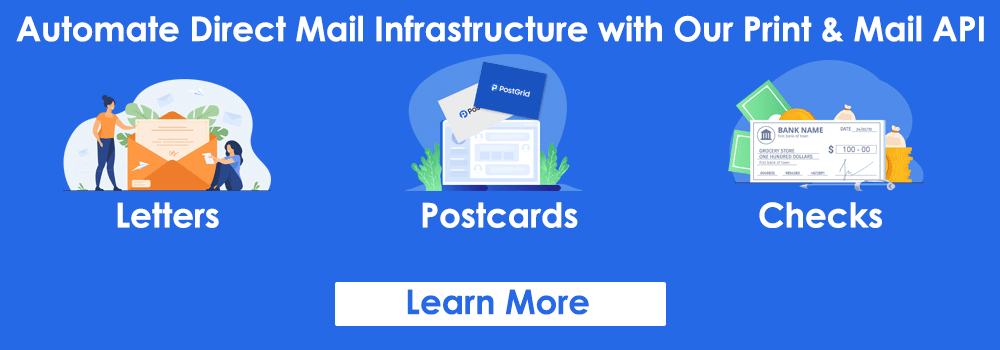Google Address Validation Vs PostGrid
Google Address Validation Vs PostGrid
To show professionalism and keep good relationships with your customers, you need to keep their accurate and up-to-date addresses in your database. Most businesses today are turning towards Google for their address mapping, as without a doubt, it’s Google after all.
Although, the results they’re expecting aren’t the same as those they’re getting because Google isn’t telling you everything.
What Google Isn’t Telling You
In this article, we’ll discuss why Google – even after being perfect – may not be the best address validation software for your business. But before we get into the details, let’s first discuss what exactly is an address validation tool, a few essential terms, and definitions that you need to know about it.
Let’s dig in.

Address Validation Tool
An address verification tool helps you clean all the data of your database by matching every detail with the data as represented in the official database of different service providers. In the case of PostGrid, it’s USPS.
Running your data through address verification software helps you reduce the number of lost direct mails, provide accurate deliverable addresses, eliminate wrong and duplicate whereabouts, and eventually save you from a lot of misspending and increase your returns.
Here are a few other features that a good address validation tool holds:
Parsing
Parsing is basically a device or a computing machine taking your data as an input, analyzing it, breaking it into pieces, and defining what each of the parts means. In the case of the address validation software, the tool breaks down the details of the addresses you have provided into different relevant parts and correctly identifies each of them. For example, “XYZ shell” is the street name, “Florida, Miami” is the city and state names, then comes the zip code, country name, etc.

But what makes it a little complicated is that sometimes some of the same acronyms have different meanings. And if your address validation software is unable to verify the data with the official database, then it may fail to gather accurate information for you. Eventually, investing in an automated tool becomes irrelevant, as it usually happens when things are done manually.
Besides that, any address validation tool needs to be paired with standardization to perform the features mentioned above to give accurate information and know whether the address you’ve entered exists for real or not. As, without standardization, your address may contain a lot of information gaps and formatting issues.
If you address validation software only parse the data you’ve entered (or it has fetched from your system), then it’ll only divide the details into its constituent parts and name them separately. But if you want it to work effectively, then combining it with the other two facets of standardization and validation is essential.
Yet, if you can get a tool that can remove the manual work of going through tons of data and labeling each of the parts, it’s still great as manual work is tedious and prone to errors.
Standardizing
Address standardization is simply taking the address from the data, filling in the missed details, correcting its format, and matching your data with the standard authority addresses.
It helps decrease the work for the postal employees, as they have to go through a large number of addresses daily. Plus, when all the addresses are in the same format, it’s easier to follow up with them, and they stay in a neat and clean state. It also assists you in keeping your data from being hard to read and scan. It also reflects professionalism as for the recipients – sometimes important clients – such things matter.

Once your data has been parsed, it needs to be standardized. Only then can it be verified, especially if you want to remove the duplicate addresses from your database and fill in the information gaps to correct the wrong addresses. So, all of your direct mails can reach the right destination. Incorrect addresses can also be a huge cause of missed sales opportunities, as some of your prospects might be interested in a particular offer that you were making only for the potential customers who left their details in your database. Still, due to bad addresses, they never got to know about those offerings.
So, just to make it more clear, address parsing and standardization are two different things. Address parsing is simply breaking the data into pieces and labeling them accordingly. However, standardization is reformatting the information. It’s not always necessary that the two happen simultaneously.
Similarly, validating the addresses is a totally different step, which is not included in the standardization.
Address Validation
Address verification or address validation is basically when you enter an address in the system. It checks the data against the standard or official database (for example, USPS) to determine if it can be reached out to or not.
If the data you’ve entered is available in the registered database, then the tool you’re using will mark it as valid, which means the address is correct, and it can be shipped to. On the other hand, if it’s not the case and the software couldn’t locate the address you entered in the standard database, then it’ll mark it as invalid.
Now, there are a lot of reasons as to why an address is invalid. For example, the address contains a typo, the database has been updated, the address has not been registered in the official database, it’s from an outside service area, or simply the address actually is wrong.
The possibilities of an invalid address to be real or not are many. Still, it cannot be said with surety that the invalid address is actually real or physically exists or not, and can a courier even reach that particular location.
So, when an address verification tool works in the right order, it parses the addresses and standardizes them before they validate them. Otherwise, non-standardized addresses won’t be easy to validate as there’s a possibility that their format doesn’t match the addresses of the official database, and, eventually, the system may declare them invalid.
Now, next comes the interfacing with the standard database, and only validation can do that. Parsing is not necessarily included in the validation process, and all the tools or software that offer parsing and standardization do not necessarily verify the addresses. But the three methods work the best and provide the best results when done together.
What Does Google Do?
Google does a lot of things, yet, there are many things that are necessary, but Google isn’t offering them. For example, Google is offering mapping services and the best search engine of all. But, it isn’t offering address parsing, standardizing, or validating those addresses.
Hence, you cannot tell if those addresses are valid, right to mail to, contain missing information, and tons of other things discussed above.
If you’re relying on Google for your addresses, then you’re only relying on the estimated data. As Google can definitely tell you about an address being somewhere on the map, it will not parse it for details or standardize it to have it in the right format.
Although, here’s what Google is actually doing with the addresses. It tells you about the longitude and the latitude of an address so that you can identify the location, next it shows the time zones and borders, and the last thing it shows is the directions to it. Eventually, a person may think it’s where you can reach someone’s whereabouts, but there’s no guarantee that it’s a valid address. As there’s no parsing standardizing and validation of the address that Google is performing, it’s just using the geocoding API whose main function is to return the coordinate details.
Hence, it may confuse you in having an address exist, which might actually not be valid and deliverable, which is why, if you’re into the shipping business, Google map isn’t a reliable option.
A Comparison Between Google and PostGrid
One of the main differences between the two is the quality of the data that you’re collecting.
When you verify the details of your database with PostGrid, it matches each of the addresses with the official database of USPS. Plus, PostGrid also checks for the deliverability of the addresses at the point of entry and lets you know if you can ship to this location or not. On the other hand, Google does no such thing, and you may not be able to find out if the data is accurate or not.
Plus, the USPS keeps updating its data year by year, and new addresses keep on adding to its database. However, in Google’s case, you may also be getting data that is a few years old and is often crowdsourced. Hence, it’s not reliable.
And these minute details not only affect your customers’ conversion rate but may also cost you money.
Next on the list is the sub-building details. On PostGrid, we describe every minute detail needed to deliver your package or letter, for example, apartments, suites, rooms, and floor numbers. However, Google only provides the outer building address, which means that you might still not get to the right recipient on time.
Plus, if we only talk about the US, Google has missing data of around 30 million apartments. On PostGrid, we provide you with the exact deliverable apartment details.
Besides that, PostGrid is super easy and quick to install and use. You can easily integrate the tool with your system, fetch the data in seconds, and get your data verified within seconds. On the other hand, to use Google autocomplete, you need technical knowledge, plus it doesn’t even provide any interface guidance.
As long as PostGrid is concerned, you can integrate it with a number of different eCommerce platforms like Magento, Shopify, and others.
PostGrid also offers to remove the branding tag from your verified addresses, unlike Google, which doesn’t. In case you need your search bar without any tag.
How to Choose Address Validation Software?
If you want to own the right address validation software for your business, then there are a few features that it necessarily should have. For example, parsing, standardization, bulk data, global data, entry point data validation, matching the data with the official database, autocomplete, and others. On PostGrid, we offer the following features:
1. Volume Data Analysis
With PostGrid, you can analyze the data in bulk. You can match tens of thousands of addresses within seconds. Eventually, save time and resources and get the mails delivered to the right locations.
2. Intercontinental Address Verification
With an address verification tool, like PostGrid, you can get the most accurate data across the globe. You can also get it parsed into different components according to the lexicons and rules with the translating and formatting services.
3. Entry Point Verification
Get the delivery status of each address in your database and make sure the on-time mail delivery to the right address and increase your sales’ chances. With this facet, it becomes significantly easier for you to find out that the mailer you’re trying to send will reach its final destination or not and whether the probability of the errors has been minimized.
4. Complementary Data
Eliminate all the duplicate addresses from your database, so you can print and mail faster. It helps you reduce the money, time, and resources wasting on the mails sent multiple times.
5. Address Validation
Collect only accurate data by integrating PostGrid into your system. Each time your customers type an address, they’ll get standard alternatives to fill in space. It reduces the time they spend on filling in the details and gives them the feel of you being a legitimate company in the business for years. Plus, it also helps remove the potential clients’ or customers’ doubts that you provide your services in a particular region where they’re based or not.
6. Autocomplete
Save your customers’ time with PostGrid’s autocomplete address feature and get them to the signup button more quickly. It helps to take the customers, prospects, or potential clients to reach the final call to action as quickly as possible. And along with that, it also helps in making the process easier for them.
7. Precise Data
The software matches up the data available or entering your system through machine learning and standard postal services data, and hence, provide you with the best data for your mailers.
8. Address Parsing
Get each address into its different components, viz., address line 1, address line 2, street, city, state, and zip code.
9. Data Cleansing
Complete the CRM integration with PostGrid and get rid of the misinformation and gaps from the fetched data.
10. Standardization
This time-saving tool can help you get all the captured addresses in the standard US postal address format.
11. Legitimate Data analysis
The software also verifies the other data like users’ phone numbers, IP addresses, email addresses, and further details along with the shipping addresses. After this analysis, it instantly lets you know if the data that the particular user is providing is risk-free and legitimate or not. Eventually, it saves you from the spams too.
12. CASS & SERP Certified
Stop spending money and resources on the lost and duplicate direct mails. Yes, we have 100% accurate CASS & SERP Certified addresses in our system.
13. Faster data verification
Get thousands of addresses verified in seconds with PostGrid, and save tons of hours of tedious work.
14. Low Cost with High Returns
Unlike our close competitors, we provide tens of thousands of address verification at a very affordable price. And with reduced misspending, you gain 30% more in revenue.
15. 24-Hour Customer Support
Our support team is available 24 hours a day. If you ever get stuck anywhere in the process, you can dial our toll-free number, and we’ll get in touch with you instantly.
Other Benefits That PostGrid Offers
Increment in overall process speed: With fast and on the spot address verification, you can completely eliminate the manual work and speed up the process, as it takes around 3-5 business days to verify the collected addresses manually.
Faster turnaround time: With less manual work and verifying the addresses instantly on submission, you can also send the requested document (or a particular offer) in comparatively less time. (NB: you can also enable priority processing for the customers who want the package at a defined time.)
Scalable services: You can verify as many numbers of addresses as you want. From thousands to millions of addresses, we help our clients verify them all.
It’s because businesses keep growing and eventually, their audience size grows depending on the different products and services they offer. That’s why companies keep on needing to increase the number of direct mails they have to send, not only for regular mails but also for advertising, offering different discounts, and following up.
Sometimes, businesses – along with their direct mail campaigns – follow up on their digital marketing campaigns with letters. Even in that case, you can use PostGrid’s services at any time.
What Happens When Your Addresses Aren’t Fully Verified
1. Missed Sales Chances
When you send your mailer to the wrong address, the person it is meant to serve may not be able to receive the provision you offered in it. The chances are that the person was willing to go ahead with that offer. Hence you missed a clear-cut sales opportunity here. Plus, if there are a number of wrong addresses in your database, then the cost of lost sales opportunities multiplies tremendously. Eventually, this practice will cost you a lot of business.
2. Misspending
You may not realize it, but when you send your direct mails to the addresses, it’ll cost you around $200-$300 per month just for the postal services. As the mailers will return and sometimes you’ll need to reship them because of some general typo in the address provided.
Additionally, if we talk about the marketing direct mails then the wrong addresses will not only cost you the shipping fees but also the printing and personalizing cost. And if you have the corporate gifting added in your marketing strategy too, then the swag cost adds up in the loss. So, technically, one simple mistake is costing you a lot of business growth and money alongside.
3. Unhappy Customers
You may think how much a little spelling mistake can cost. In business, let us assure you—a lot. If you keep sending irrelevant offers or discounts to your unrelated prospects or customers because of a simple typo, they may get frustrated. And this frustration may result in them opting out of your services or never buying from you again. Hence, you lost some of the customers for life. And that’s a huge loss to the business. Especially when you know you’re sending thousands, if not millions, of direct mails regularly.
4. Capital Loss
Have you ever noticed, apart from money, a tremendous amount of physical and human resources are involved in direct mail marketing? When you mail a significant amount of mailpieces to the wrong or incomplete addresses, not just the money, sales, and networking opportunities, but also the resources involved suffer a considerable loss. However, it can be avoided with the right address verification tool, like PostGrid.
5. Company’s Reputation
When you send mailers to the wrong addresses or with typos on them mentioned on the mailpiece envelope, you may face significant problems. The first problem is that the direct mails are not only about marketing, but you use them to send the letters too, and sometimes they may contain sensitive information in them. Mailing such reports to the wrong address may get you in serious trouble, and the customers probably wouldn’t be willing to do more business with you. The second thing to note is that if you mail your prospects or clients with a typo in their names or addresses, they might think you’re not a professional, which may hurt your brand reputation.
Wrapping Up
To maintain your professional relationships and better user experience, relying on estimation is never a good idea. Hence, try an address validation tool that genuinely understands your business’s needs and provides you the right and complete results.
The post Google Address Validation Vs PostGrid appeared first on PostGrid.
source https://www.postgrid.com/google-address-validation/
source https://postgridplatform.blogspot.com/2021/01/google-address-validation-vs-postgrid.html


Comments
Post a Comment